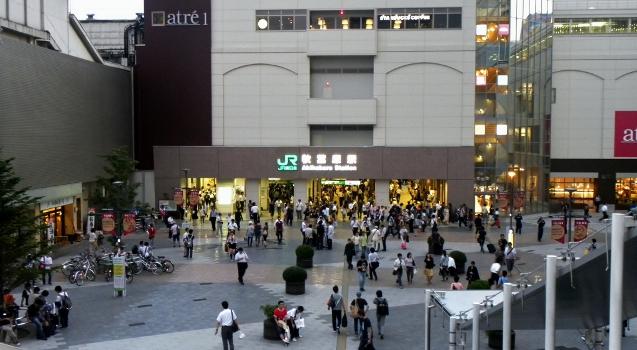General Information
| Status: | in use |
|---|
Project Type
| Function / usage: |
Railroad (railway) station |
|---|
Location
| Location: |
Akihabara, Chiyoda, Tokyo, Tokyo, Japan |
|---|---|
| Connects to: |
Akiba Bridge (2006)
|
| Coordinates: | 35° 41' 53.52" N 139° 46' 26.40" E |
Technical Information
There currently is no technical data available.
Excerpt from Wikipedia
Akihabara Station (秋葉原駅, Akihabara-eki) is a railway station in Tokyo's Chiyoda ward. It is at the center of the Akihabara shopping district specializing in electronic goods.
Lines
Akihabara Station is served by the following lines. JR East:
- Tōhoku Main Line
- JK Keihin-Tohoku Line
- JY Yamanote Line
- Sōbu Main Line
- JB Chūō-Sōbu Line
Tokyo Metro:
- H Tokyo Metro Hibiya Line
Metropolitan Intercity Railway Company:
The above-ground section of the station is cross-shaped, with the Chūō-Sōbu Line tracks running from east to west, and the Yamanote and Keihin-Tohoku Line (and Tohoku Shinkansen and Ueno–Tokyo Line, which do not stop at Akihabara) from north to south.
Station layout
JR East
There are two island platforms serving four tracks for the Yamanote Line and the Keihin-Tohoku Line on the 2nd level, and two side platforms serving two tracks for the Sobu Line Local service on the 4th level.
Chest-high platform edge doors were installed on the Yamanote Line platforms in May 2015, to be brought into operation from 20 June 2015.
Tokyo Metro
H15 Akihabara Station 秋葉原駅Tokyo Metro Hibiya Line No. 3 Entrance in December 2006LocationKanda-Sakuma-chō Chiyoda, Tokyo JapanOperated byTokyo MetroLine(s)H Tokyo Metro Hibiya LineConnectionsBus terminalHistoryOpened1962
There are two underground side platforms serving two tracks.
Tsukuba Express
There is an underground island platform serving two tracks.
History
Akihabara Station was opened in November 1890 as a freight terminal linked to Ueno Station via tracks following the course of the modern day Yamanote Line.
It was opened to passenger traffic in 1925 following the construction of the section of track linking Ueno with Shinbashi via Tokyo Station and the completion of the Yamanote Line. The upper level platforms were added in 1932 with the opening of an extension to the Sōbu Line from its old terminal at Ryōgoku to Ochanomizu, making Akihabara an important transfer station for passengers from the east of Tokyo and Chiba Prefecture.
The huge growth in commuter traffic following the Second World War caused considerable congestion and was only relieved with the construction of the Sōbu line tunnel linking Kinshichō with Tokyo, bypassing Akihabara.
The Hibiya Line subway station was opened on May 31, 1962, with the line's extension from Naka-Okachimachi to Ningyōchō.
On August 24, 2005, the underground terminus of the new Tsukuba Express Line opened at Akihabara. The entire station complex, including the JR station, was also refurbished and enlarged in preparation for the opening of the Tsukuba Express.
Passenger statistics
In fiscal 2013, the JR East station was used by an average of 240,327 passengers daily (boarding passengers only), making it the ninth-busiest station operated by JR East. Over the same fiscal year, the Tokyo Metro station was used by an average of 122,576 passengers daily (both exiting and entering passengers), making it the 23rd busiest Tokyo Metro station. The passenger figures for previous years are as shown below. Note that JR East figures are for boarding passengers only.
Text imported from Wikipedia article "Akihabara Station" and modified on July 23, 2019 according to the CC-BY-SA 4.0 International license.
Participants
Currently there is no information available about persons or companies having participated in this project.
Relevant Web Sites
- About this
data sheet - Structure-ID
20033452 - Published on:
27/11/2007 - Last updated on:
08/05/2021





